Winnie the
WAC
And the
Other Adventures of Her Creator, Vic Herman
Winnie the
WAC was to the Women’s Army Corps in World War II what Dave Breger’s Private
Breger and George Baker’s Sad Sack and Bill Mauldin’s Willie and Joe were to
the entire U.S. military—a moral booster nonpareil. 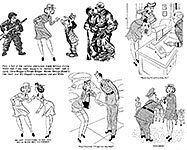 . As the only cartoon cutie in the
ranks, she’d returned to duty for the Korean War and, subsequently, for the
hostilities in Vietnam. And in 1993, she was back on active duty—this time,
recruiting for the Women's Army Corps Veteran's Association. And that’s when I
met Winnie’s creator, Vic Herman. . As the only cartoon cutie in the
ranks, she’d returned to duty for the Korean War and, subsequently, for the
hostilities in Vietnam. And in 1993, she was back on active duty—this time,
recruiting for the Women's Army Corps Veteran's Association. And that’s when I
met Winnie’s creator, Vic Herman.
Winnie’s
1993 enlistment began in the spring of that year when Major Rose McGowan, a
retired WWII WAC, discovered that Herman lived in Del Mar, a residential
community within a few stones' throws of San Diego, where McGowan was planning
a 51st WAC anniversary luncheon for the San Diego Mission 50 of the WAC VA.
McGowan promptly secured Herman as a guest of honor for the luncheon, and
within weeks, Winnie was on recruiting posters.
It
was Winnie's fifth comeback. And we should not be surprised at this
unanticipated reincarnation. She takes after her creator, who has spent a
lifetime popping up in unexpected places, first in one career and then in
another. But with Herman, we lose count pretty quickly.
Herman
has been a puppeteer, illustrator, cartoonist, war correspondent, television
producer, art director, head of advertising agency, author, good will
ambassador, and painter. None of these were part-time employments: in every
case, he threw himself wholeheartedly, full-time, into the role he'd chosen and
made a success of it.
And
while running this variegated occupational obstacle course, Herman participated
in the creation or revitalization of several icons of the advertising
world—Elsie the Borden Cow, Reddy Kilowatt, Johnny the Philip Morris Messenger,
and Johnson & Johnson's Sad Shad, not to mention some slightly lesser known
figures, 7-Up SAM and $2 Joe. 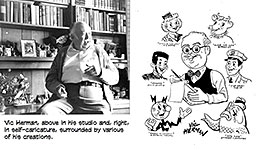
And
Winnie.
Winnie
was Herman's first big success, and she's wholly owned by Herman.
Herman,
who is an honorary lifetime member of the WAC, invented his khakied pin-up
shortly after he was drafted in 1943 and posted to Aberdeen Proving Grounds in
Maryland for basic training. Herman had already established himself in
advertising and as a freelance cartoonist, and his superiors encouraged him to
continue in the latter endeavor during his putative free time. He did so,
attracting the attention of the editor of the base newspaper, The Flaming
Bomb. And when the editor interviewed Herman, he ended by asking the
cartoonist to invent a character for the paper.
Winnie
was the result. She was an immediate success, particularly among WACs.
"She made us laugh at ourselves," said Lita Bowman, a San Diego WAC
and WWII veteran. "She did what we did, saw the world the way we did, and
she was our hero."
Says
Herman: "I was frequently asked how I, being a man, could depict women so
well. I was lucky: I was one of the only men allowed into the women's
barracks." And into their mess hall and other behind-the-scenes locales
where he saw WACs in action and distilled from what he saw the gags that
animated Winnie.
Within
weeks, Winnie the WAC was being distributed to base newspapers worldwide
by the Army's Camp Newspaper Service (CNS), a clipsheet that included Milton
Caniff's Male Call, Leonard Samsone's The Wolf and cartoons by
Herblock. Appearing in 1,200 base papers, Winnie was an asset to be
exploited.
The
Army sponsored a Winnie look-alike contest and picked WAC Pfc Althea Semanchik,
and she and Herman went on highly publicized public relations trips to recruit
women for the WAC. In 1945, the Army Ordnance Department voted Winnie
"Ordnance Joe of 1945," an honor usually reserved for a male (and a
live one at that), Life magazine ran a three-page spread on Winnie in
the March 19, 1945 issue, and later that year, Herman published a collection of
Winnie cartoons. The book, a slender volume, sold for a buck, 50,000 copies
worth.
All
of a sudden, Herman was a famous cartoonist. But he didn't set out to be a
cartoonist.
A
man of many parts, as I've noted, Herman has two distinct artistic facets—a
realistic side and a cartooning side. And he was able to capitalize on both,
due, probably, to a talent for showmanship—a talent fostered by his earliest
experiences, which were in show business.
Although
he was born in Fall River, Massachusetts (May 12, 1919), Herman grew up in
Hollywood. His father, who was playing violin for Paul Whiteman when Herman
was born, moved his family to Los Angeles in 1921 to take a job with Fox
Studios, playing in the orchestra that supplied mood music for silent films.
The Hermans took a house on Beechwood Drive, just under the sign on the hill
overlooking the city that advertised the housing development in the vicinity—"Hollywoodland."
Herman
attended Cheremoya School, and since many of his classmates there and through
junior high school were Mexican-American, he acquired conversational Spanish
and learned to appreciate the culture of his fellow students. And like most
embryo cartoonists, he drew pictures.
"I
never thought in the beginning that I'd be a cartoonist," he told me when
I visited him in December 1993. "I was interested in drawing, but I wanted
to capture what I saw realistically. And my realistic side shows the Spanish
influence. I don't do cartoons on Mexico and Spain. That's pretty
serious."
Herman's
father, eager to advance his son's various aspirations, arranged for the boy to
have the run of Fox Studios. Young Vic learned about casting, characters,
scripts, costumes, color, camera angles and distance, timing, staging, and so
on. Watching movies being made, he gained some understanding of the ways
visual, literary, and musical elements could be combined into a unified whole.
When
Herman was about eleven, his mother, also an artist, helped him to an
apprenticeship with the Yale Puppeteers, a marionette team then producing shows
at the Teatro del Toro (Theater of the Bull) on Olvera Street in the Mexican
district of Los Angeles.
Herman’s
parents divorced in 1931, and in 1933, Herman and his mother moved to Bayonne,
New Jersey, to live with her parents. By this time, Vic, fourteen years old,
was an accomplished puppeteer, managing a repertory cast of 35 puppets, which
he had made himself out of wood with wires for joints. He staged puppet shows
in "El Teatro Pequeno" (The Little Theater), the basement of his
grandparents' home. He produced four shows: Pinocchio, Treasure Island,
Cinderella, and Uncle Tom's Shack ("shack" rather than
"cabin" to avoid payment of royalties; entrepreneurial cunning came
early).
A
fifth show was a Hollywood revue, with a variety of entertainment-world
characters—a talking monkey, a dragon that belched fire, and a Pagliacci clown
(crying on the inside while laughing on the outside), a boop-boop-a-doop girl,
a trained dog (reminiscent of Rin Tin Tin), one of the dwarfs from Rip Van
Winkle, and so on.
Herman
gave performances at Bayonne Free Library, and, while a mere teenager, lectured
at Columbia University before a class of students and professors of puppetry.
At
Bayonne High School, Vic was editor of the school paper, The Beacon, the
staff of which grew to sixty while his senior year. He also drew decorative
pictures and column headings, his first cartoons. And he became a crusading
cartoonist/editor/journalist.
The
school’s population was increasing in size so rapidly that the principal asked
Herman to do a cartoon requesting President Franklin D. Roosevelt to enlarge
the school for its growing student body. Hermand did a cartoon showing FDR
putting into the hands of Principal Daniel P. Sweeney a new and larger school.
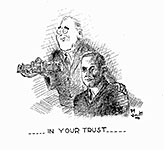
Subsequently,
Roosevelt wrote Sweeney, promising to do something to improve the school
building and saying that Mrs. Roosevelt would visit the school to obtain the
original art for the cartoon. Herman has been told that the original hangs in
the Roosevelt Collection in Hyde Park, New York.
After
graduating from high school in 1937, Herman went to work in the art department
of Warner Brothers East in New York City where ads, posters and billboards for
the studio's movies were made. (Among his assignments, the background figures
on the Bogart-Bergman “Casablanca” poster.) Evenings, he attended classes at
the Art Students League, studying under renowned George Bridgman. Living now in
Greenwich Village, he also took courses at the Commercial Illustrators School
in the Flatiron Building in New York.
Herman's
next stop was with the advertising agency Denker, Johnson, and Fleck, where he
specialized in figure drawings made in pen and ink, scratchboard, and brush and
ink wash. After two years, he left for a position with the prestigious Young
and Rubicam ad agency. There, he met Elsie the Cow.
Elsie
had been a symbol for Borden for years, but she had always appeared as a real
cow. Now, Borden wanted Elsie to have more personality. The assignment was
given to Herman and other freelance cartoonists who had been working on the
Elsie account.
"When
I started working on Elsie," Herman said, "she was on all fours. And
then we stood her up. When we stood her up, we had to figure out how to cover
her up. But that's an udder story," he quipped, savoring the bad pun that
he delighted in repeating whenever he told this story.
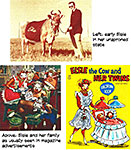 They
put an apron on Elsie, and the cow and her family became characters in
page-long illustrated dramas—comic strips. They
put an apron on Elsie, and the cow and her family became characters in
page-long illustrated dramas—comic strips.
While
working at Young and Rubicam, Herman also freelanced cartoons to magazines. He
sold his first one to the venerable humor magazine Judge in 1940. After
that, he sold to all the big glossy weeklies— Saturday Evening Post,
Collier's, Liberty, as well as Esquire and others. Then in 1943, he
was drafted into the Army.
After
completing basic training at Aberdeen, Herman was assigned to the Army's Motors magazine as a field artist correspondent. His experience making on-the-spot
sketches would come in handy in one of his later careers, as we shall see. He
also drew posters, one of which showed a soldier sitting on a toilet with the
caption: "My Censored Is Moist—Raise Toilet Seats!" It was posted in
Army latrines around the world.
But
his most celebrated accomplishment during the war years was the creation of
Winnie the WAC. Before the war's end, Winnie was translated into a movie with
the luscious Carole Landis in the title role. (Herman had script approval but
wasn't much involved in the production; oddly, the Wikipedia entry for Landis
fails to list this movie as one in which she appeared.)
At
the height of their fame, Herman and Winnie were given a mini-parade on New
York’s Fifth Avenue that terminated on the steps of City Hall where they were
met by Mayor Fiorello LaGuardia.
Winnie
retired after the War but returned to active duty during the Korean War
(1950-52) and again during the Vietnam conflict (starting in 1966). For both
these morale-boasting efforts, Herman volunteered his creation in the form of
reprinted cartoons, up-dated from their original publication in the 1940s. And
she came back twice more on less belligerent occasions: the USO drafted her in
1954 for the United Defense Fund drives; and in 1985, Winnie helped the U.S.
Treasury Department sell savings bonds.
Briefly
in 1991, it seemed possible that Winnie would return for the war in the Persian
Gulf. “I hope not,” Herman said at the time, “—because I don’t want this
conflict to become another Korea or Vietnam. But if things do go bad over
there, I wouldn’t mind bringing her back to pep up moral among the troops.”
IN 1946,
HERMAN RETURNED to civilian life, trumpets blaring. Now celebrated as Winnie's
creator, he cranked out a cartoon brochure with a self-caricature on it to
announce his availability for any and all assignments. William Randolph Hearst
saw the brochure and thought Herman’s face on it was too funny to lose. He
commissioned Herman to illustrate Bob Considine's column, and when Considine
wrote about the race track, Herman's pictures featured a self-caricature dubbed
$2 Joe, who usually lost his wagers. (It was, perhaps, prophetic, as we shall
see anon.) 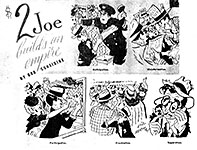
Herman
freelanced magazine cartoons to all the big markets (in order to hit them all,
his wife Miriam often made part of the weekly “look day” rounds every Wednesday
for him), and he did advertising cartoons.
One
day, a young fellow knocked on his studio door and volunteered to do cartoon
roughs for him; it was Mel Lazarus. Lazarus left after six months or
so, and a few months later, he phoned Herman. Lazarus was now art director of
Toby Press, the company owned by Al Capp and his brother Eliot Caplin.
And Lazarus offered Herman an assignment drawing himself in a 16-page Li'l
Abner comic book that would be used to recruit for the Navy. Herman’s
self-caricature’s name was Drawing Board McEasel. (When I interviewed Herman,
he got a chuckle out of the notion of the creator of the WAC heroine doing
recruiting for the Navy.) 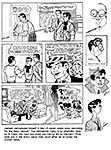
By
1948, the advertising side of the operation had become so lucrative that he
formed his own cartoon advertising production company, Vic Herman Productions,
Inc. The company made television commercials, too. (Hal Holbrook once worked
in a Herman production.)
Among
Herman's clients were Western Electric, Philip Morris, Johnson & Johnson,
and 7-Up. Through them, Herman met Reddy Kilowatt, Johnny the Messenger, Sad
Shad, and 7-Up SAM and others not quite so well-known.
"I
did Reddy Kilowatt on and off for about twelve years," Herman recalled
when I interviewed him. "About the same length of time I did Elsie. I
didn't create either one of them, but Johnny was partly my creation. They had
been using just the head of the character, and when I came into it, I dressed
him up and used him at his full height." 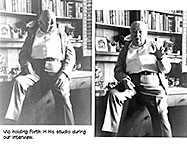
Sad
Shad was a character Herman created to promote the clean-up of New Jersey
riverways. And he created 7-Up SAM to help 7-Up salesmen.
The
7-Up people came to Herman in 1956. The assignment was to create a dramatic
and interesting visual training program that would convey timely sales
instruction messages to 7-Up salesmen every month. The vehicle they selected
was an illustrated pamphlet, a comic book. Working with 7-Up marketing vice
president Bill Winter, Herman first devised the name of the character: SAM,
which stands for Selling, Advertising, and Merchandising.
Every
month, SAM would appear in a short story that presented a sales message geared
to current nation-wide 7-Up promotional efforts. The story format was
crucial: SAM would never preach; he would show through his own
actions how to increase sales. 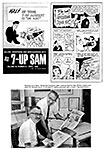
Once
the magazine was launched, Herman worked with 7-Up sales training director Bob
Britton. They met monthly in St. Louis to coordinate SAM's activities,
preparing stories for the publication three months in the future. During one
such meeting, they might rough out a script for the next issue, prepare a
synopsis of SAM's activity for the following month, and begin discussing themes
for the issue after that. Actual scripting was done in Herman's New York
studio, as was the artwork.
But
Herman wasn't content to take ideas from the company's home office sales
force. He researched his subject by traveling back and forth across the
country, attending 7-Up schools, training seminars, regional meetings. In this
manner, he made certain that 7-Up SAM was fully aware of the problems and
challenges faced by his readers. Before producing the first issue (September
1956), Herman spent six months in the field, working routes with 7-Up salesmen.
"It
went over very well," Herman said. "I did 7-Up SAM magazine every
month, for seventeen years."
"How
do you come up with all these characters?" I asked.
"Think,"
Herman said. "I think."
By
way of example, he related the creation of Winnie, short and sweet:
"They
gave me a week to come up with the character. I wandered around the area to
see what was there, and I found out Aberdeen had the largest contingent of WACs
in the U.S. Army. It was obvious. So I came up with Winnie the WAC."
"So
you came up with Winnie because there were all these WACs on the base?" I
said.
"Right."
"And
there were already plenty of male cartoon soldiers," I continued.
"Mauldin's Willie and Joe, George Baker's Sad Sack, Dave Breger's Private
Breger, Dick Wingert's Hubert. But no women characters. No WACs. Until
Winnie."
"Right,"
Herman said.
Writing
the Foreword to the Winnie the WAC book, starlet Carol Landis revealed
some of the production hurdles Herman encountered (relying, no doubt, on what
Herman had told her: “The first Winnie cartoons were drawn while Vic was out on
a five-day bivouac. Others were sketched from a hospital bed while Vic
recovered from the baleful effects of a ptomaine attack. Still others first saw
the light of day on Saturday night train rides from Aberdeen to New York. And
some where even drawn quietly and calmly at Vic’s desk in the Ordnance School,
where he spends his days assisting in the preparation of training aids for
Ordnance soldiers.”
Herman
donned khaki once more in 1965. The National Cartoonists Society staged a
dinner and gala in honor of wartime cartoonists called “War Cartoonists Nite,” and
Herman was asked to make all the arrangements. It took him six months to put
it all together.
Written,
produced and directed by Herman, the event took place September 22 at the Hotel
Astor. Over 500 guests attended the dinner and the USO show afterward. The
chief attraction of the evening was a film produced by Herman that depicted the
efforts of over 125 wartime cartoonists culled from fifty years of soldiering
comics features. Guests of honor included General Omar Bradley, Walter
Cronkite, Fred Waring, and John Daly.
Herman
chuckled, recalling the evening: "I got Hugh Hefner to loan us twenty
Playboy bunnies from the New York Playboy Club to act as hostesses. Hef said,
‘I'm giving you twenty bunnies for one night. And Vic,’ he said, ‘that's one
night only.’"
Herman
grinned, looking not just a little like Esky, the familiar moustached roue that Esquire deployed as its mascot for years.
Actually,
Herman has been mistaken for Walter Cronkite more often than Esky.
He
told me about an incident that took place in the famed Pen and Pencil
restaurant where cartoonists usually convened for lunch midway through
Wednesday’s peddling day at magazine editors’ offices.
“One
Wednesday,” Herman said, “I’m eating lunch and I was delighted when a young lady
came up to me and pushed a note pad in front of me, saying, ‘May I have your
autograph?’ I was overwhelmed,” he continued. “I asked for her name and she
gave it to me, and I then wrote out a note to her thanking her for following me
in my artwork.
“Well,
she looked at my note and then at me and then again at the note and again at
me. Then she shoved the signed notepaper back to me and said, angrily: ‘I
thought you were Walter Cronkite.’”
For
his work on “War Cartoonists Nite,” Herman was presented with the NCS Award of
Honor.
IN 1960,
HERMAN TOOK AN ASSIGNMENT with Gourmet magazine, which sent him south of
the border to draw and paint the people and places of Mexico.
"That
was it—the turning point of my career," Herman said. "I went back to
Mexico, the old affection was rekindled and I was hooked for good. Ever since,
almost everything I've done has had a south of the border theme."
Parents
Publications commissioned him to write and illustrate children's books in its
Hispanic Southwest series, and Herman went back to Mexico again to research his
material, making sketches and paintings. The Mexican government took note of
the authenticity of his paintings and in 1961 began sponsoring exhibitions of
his work in the U.S. and Mexico. His one-man show, "The Many Faces of
Mexico," has traveled all over both countries. In 1967-68, it was mounted
twenty-one times in the two countries.
But
Herman's paintings are not merely mug shots. The paintings tell stories.
Simple but revealing tales. Without any kind of verbal caption, a painting may
say, "This is a Tarascan woman selling jicamas." Or, "This
youngster fishing with a net in the Boca del Rio Lagoon [in Veracruz] is an
apprentice in the commercial fishing trade."
His
work has earned the highest accolades—praise from many on both sides of the
border.
Said
Joaquin Touz Lo, noted art critic for La Nacion, Veracruz's leading
newspaper: "We were greatly surprised to see true Mexican art of this
form by an American artist. We found ourselves face to face with a fresh, new
realistic approach to painting. These are truly sensitive works, as gratifying
to the eyes as to the soul. These are the works of a many who has captured the
true feelings of Mexico today; the happiness and poetry of its people and has
felt the need of conveying his impressions with masterful strokes of the brush
into a `pictorial diary' of our daily lives so that others can share
them."
John
Brown, cultural affairs officer of the U.S. Embassy in Mexico City: "Vic
Herman has a special fondness for the Mexican people and he knows them
well."
Perhaps
the ultimate compliment, from Father Benjamin Fernandez Valenzuela of Morelia,
Michoacan: "Senior Herman paints with the hand of an American and the
heart of a Mexican."
Said
Herman: "If the many peoples of Mexico, when seeing my exhibitions,
accept my paintings as authentic in telling the story of their daily lives, and
if the peoples of the United States understand the dignity, culture and arts of
the Mexican peoples, I feel that I will have fulfilled the purpose of my
activities—that is, helping to cement the friendship between our two
countries."
Dubbed
"Ambassador with a Brush" by American Artist magazine, Herman
has spent months in Mexico over the years, prowling the country in his station
wagon searching for subjects. Typically, once he found one, he would begin
with a pencil sketch to capture the subject's likeness, sometimes with the
subject's knowledge; sometimes not. Next, he made several thumbnail sketches
to indicate the composition or pattern of the entire final picture. Sometimes
he worked with the model for a couple of days.
To
record the colors, he took color slides. When feasible, he actually bought the
clothing his subject was wearing—sombrero, shoes, rebozo (shawl), serape,
skirt, whatever— and sometimes other articles that would be pictured. With
these items at hand to guide him in the final painting, he gave the work
authentic texture as well as color. All these accouterments were tagged and
packed away in his station wagon for his return trip to the U.S. On one
occasion, an entire ox cart was dismantled and brought home in this fashion.
Back
in his studio, Herman often used a professional model to recreate his subject,
and, using the sketches and notes he collected in the field, he completed the
painting. When he was actively painting, a typical day began at 5 a.m. He
sometimes worked for a month on a single painting.
Herman
has published over 50 children's books as a result of his Parents Publications
assignment. Determined not to do the "Myrtle the Turtle" kind of
kids' book, Herman sought to depict the lives of Mexican people as
authentically as possible. And that meant research. Juanito's Railroad in
the Sky (Golden Press, 1976) is a good example.
Aimed
at ages 7-11, Juanito tells the story of a young Mexican boy's first big
test in life. When he's riding in the locomotive with his father, an engineer
on the famed Los Mochis to Chihuahua line, his father is suddenly beset by such
troubles as running out of fuel, dealing with difficult passengers, and even
life-threatening dangers. Juanito must help out and cope on his own. And he
does.
Passionate
about details and accuracy, Herman spent three years researching the visuals
for the book. He made over 20 trips to Mexico, riding horseback down over
treacherous trails into canyon regions, and even strapped himself to the
cowcatcher of a train for the 75-mile run between Los Mochis and Chihuahua to
take photographs of the terrain so his illustrations would be authentic.
"I
go where the action is," Herman said. "That's the way I covered
stories when I was a war correspondent, and that's the way I write my
books."
Another
time, while researching a book about fishing, Herman waded chest-deep into the
ocean to photograph men hauling in their nets. Suddenly, he heard people on
the shore screaming, and before he knew it, a shark sped by him, tearing at his
arm.
Juanito received a special award in graphic competition. And because of its
sensitivity and touching commentary with scenes of everyday life, it was
designated as an "Official Bicentennial Event" by its publishers, who
printed an unprecedented 75,000 copies in the first printing.
In
1968, Herman left New York and moved to southern California to be closer to the
Mexican heritage he loved. He kept the 7-Up account until 1974 and some of the
other accounts "until they wore out.” Others never wore out and were kept going
by the clients for years. By the end of the decade, Herman was wearing out,
too. "The traveling got me," he said. "I didn't retire, but I
was pushing sixty, and the traveling I did every month was incredible."
By
this time, he had clocked over 700,000 air miles working his accounts. And in
1977, his wife Miriam passed away.
DURING MY
VISIT, Herman took me and a couple mutual friends, Shel Dorf and A.R.
"Tommy" Thompson, on a tour of his Del Mar studio, which he had built
in 1970. A building entirely separate from the Herman Hacienda, the studio is
more like a second elegant home than a workshop. But it is thoroughly
functional.
The
walls of the studio's three large rooms are hung with Herman's drawings and
paintings, posters, and other memorabilia of his varied career, including
photographs of Herman with various celebrities, politicians and entertainers.
The largest room, half the building, with high cathedral ceiling and plenty of
windows, is the studio in which he paints. One tall wall is a pictorial museum
of Herman's career. Framed photos of Herman at various functions and
occasions, certificates, citations, awards, proclamations from presidents and
schools and associations.
At
the opposite end of the building is a sort of library with book shelves that go
from floor to ceiling—books on art, business, music, puppetry, writing,
journalism—and a desk. On one wall, a map of the North and South America is
studded with pins that identify the places Herman has been or is researching.
Then hidden away behind this room is the "workroom"—layout tables,
light tables, an enlarger, photoprocessing equipment, a bank of seven filing
cabinets filed with scrap, Herman's "morgue" of visual references.
In
every room, built-in cabinets store correspondence, records, mailing lists,
tools and working materials, publicity and public relations releases.
Altogether, a model of orderliness, a working studio that is also a small museum
of Herman's life and work.
Sadly,
when Herman died April 14, 1999, this picturesque personal monument and
workshop was his no longer.
Herman
loved playing the ponies. And once a year, he organized Cartoonists Day at the
Del Mar Racetrack. But he went there more often. Like $2 Joe, he’d placed too
many bets that didn’t pay off. He had to sell his property to pay his gambling
debts.
But
when I visited him in 1993, Herman was still adding to the trove in the files
and on the walls of his workshop/museum. Winnie the WAC was back, after all,
and there was work to be done. And Herman's wife Virginia was helping with the
work. She produced T-shirts and greeting cards featuring Winnie. Both the
Hermans are enthusiastic about Winnie's comeback—even though Ginny is an
ex-WAVE, a division of the Navy, “Women Accepted for Volunteer Emergency
Service” (WAVES, a laboriously contrived acronym for the ocean-going branch of
the military).
Return to Harv's Hindsights |